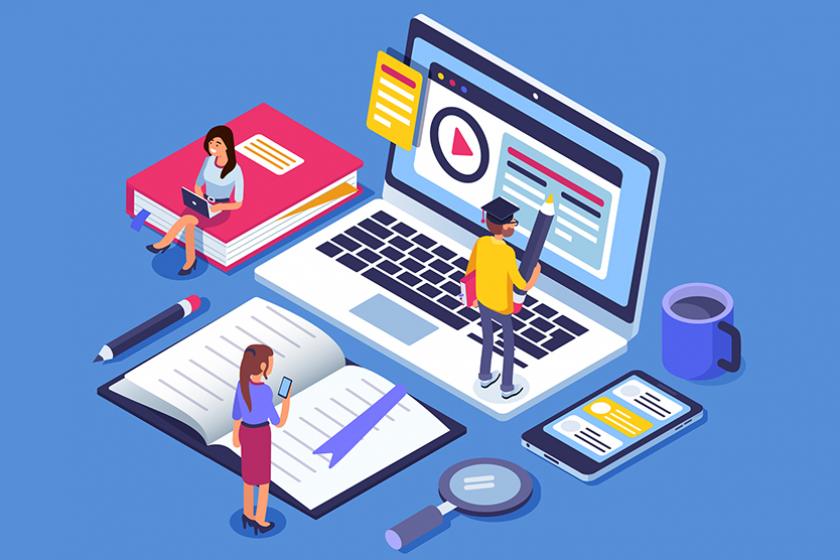10 Billion In 3 Years In EdTech: Is The Amount Invested Adding Worth To Rejuvenating Educational Systems?
Over USD10 billion was invested in Indian EdTech startups between 2020 and 2023, according to Tracxn, an entrepreneurship data platform.

Few industries in the nation saw the pandemic unleash as much change across the ecosystem as education did. Suddenly, the school shrunk to the size of a smartphone or a laptop, paving the way for the emergence of the EdTech structure. While teachers and kids struggled to adjust to the classroom-in-a-screen, parents wondered if any learning was taking place at all or if it was merely a temporary solution. On the other hand, the EdTech industry was attempting to make sense of the transition that was taking place. Many businesses used it as a beautiful presentation for investment and were successful.
Over USD10 billion was invested in Indian EdTech startups between 2020 and 2023, according to Tracxn, an entrepreneurship data platform. Not only that but over 2,000 new EdTech firms were founded in 2020 alone, more than double the average number of companies founded yearly in previous years.

Examine this information from the perspective of another World Bank statistic. Learning poverty in India, defined as the inability to read and comprehend a short, age-appropriate text by the age of ten, was already at 55% before the pandemic. While India has not participated in the Programme for International Student Assessment (PISA) in recent years, making global standards impossible, this percentage must have climbed much more in recent years.
On the one hand, billions of dollars are being invested in the industry, and new competitors are entering the field, sensing potential in a sizable untapped market. On the other hand, students’ basic learning levels are declining while they should be increasing. What is the source of this dichotomy? How can the sector meet the most fundamental of goals – learning outcomes? May new business models supported by finance solve this, and may technological improvements enhance the outcomes!
The news amidst the noise in the EdTech sector.
According to Aarushi Jain, partner and head of education, media, and gaming at law firm Cyril Amarchand Mangaldas, attaining learning outcomes in India is a long-term process, but the solutions are powerful. Patience is required for educational improvement and learning outcomes. So far, they’ve seen the most investment in exam preparation. She claims that success in tests is the area where the results are most obvious. The true underlying transformation in education, however, will occur at opposite extremes of the spectrum.
- The first is to promote fundamental learning in the K-12 ecosystem.
- The second is to increase vocational and skill-based education for employment.
Jain feels that the 2020 National Education Policy (NEP) implementation is providing possibilities in the K12 sector and the underdeveloped field of assessments, as well as causing a shift in the higher education segment. Another area where she sees a possibility is in skilling universities. The government has been opening doors for more designated universities focused on skilling. These regions demand a closer examination. But first, a status check at the school level, particularly in light of the NEP, will aid in a better understanding of the challenges.

K-12 segment: from B2B business models to assessment adjustments- Examples of a few EdTech corporations.
Consider the Singhania Group, which has been running schools for over 50 years. According to Brijesh Karia, COO of Singhania Education, Quest Plus, an EdTech solution created before the pandemic, is now gaining popularity as a NEP implementation partner in developing skills such as critical thinking and problem-solving. They are also focusing on teacher training in accordance with NEP criteria. Singhania Education’s experience running schools aids in the resolution of real-world issues that every player in the ecosystem experiences. No one can take the position of the classroom and the teacher. A 55-year-old teacher must now utilise Zoom. While excellent teachers cannot be replaced, they do require good technology. He claims the question is not “Why tech,” but “Which tech?”
According to Singhania Education, adopting a B2B approach, such as the one used by Quest Plus, is the path to achieving scale. Karia feels the K-12 market is vast, with 20,000 CBSE schools and many low-cost private schools. Quest Plus has 55,000 members in just two years, with INR22 crore in sales and a positive profit after tax at prices ranging from INR100 to INR300 per student.
Educational Initiatives is another organisation with almost two decades of experience in the sector. When they started, they discovered youngsters were just reciting concepts rather than understanding them. According to Pranav Kothari, CEO of Educational Initiatives, understanding requires asking the right questions. The organisation also discovered flaws in the evaluation procedure. While exams are necessary, planning for a terrible test is problematic. Kothari says that there is no curriculum in real life.
Educational Initiatives has created two solutions to solve these issues and allow long-term learning outcomes:
- ASSET for assessments.
- Mindspark for remedial and adaptive learning.
The firm primarily serves schools in the private, public, and low-income sectors through a B2B strategy. B2C is enabled but not promoted through marketing. Kothari claims that during the height of the financing frenzy, it did not experience withdrawal symptoms and instead conducted a few marketing tests. It remained focused on working within the school ecosystem, where much work on learning efficacy may be done. According to Kothari, they have grown at a 40% CAGR over the previous two years and are profitable and steady, with no layoffs. Yeah, that’s a good thing, unlike BYJU.

With only the top 50,000 schools, they see a USD2 billion opportunity. He values the K12 market at USD6 billion in total. Educational Initiatives also collaborates with CBSE, ICSE, and several state educational boards to ensure long-term assessment improvements by experimenting with voice recognition and artificial intelligence. It is, for example, employing generative AI to carry out sentence repairs with natural language processing and to construct models where tales may be built with children’s inputs to boost engagement.
Educational Initiatives has conducted five independent assessments of its activities to assure learning efficacy and outcome. Kothari believes that any learning intervention should be assessed.
Vibgyor Group of Schools is another educational system that has grown and embraced EdTech. According to Rustom Kerawalla, founder and chairman of Vibgyor, the network made substantial reforms to adapt to the altered educational landscape following the pandemic. Classes 11 and 12 have embraced flipped classrooms, embracing more participatory and student-centred techniques. According to Kerawalla, they have advocated using digital-learning resources and online training to improve engagement and accessibility. Recognising the significance of family involvement, Vibgyor has made initiatives to encourage parental participation across all of its schools.
Other organisations focused on the school’s B2B segment include Lighthouse Learning, Orchid Schools, LEAD School, and Extramarks.
But how are these outcomes-based learning opportunities related to current government initiatives?
The NEP push and learner-centred design of educational technology solutions.
The government’s NIPUN Bharat goal seeks to achieve universal fundamental literacy and numeracy in primary schools by 2025, according to a current source from the Central Square Foundation, which strives to provide quality school-level education.
Similarly, in 2021, the Michael and Susan Dell Foundation established the Bharat EdTech Initiative, a multi-partner consortium to bring together on-the-ground community organisations and high-quality EdTech solution providers to promote at-home EdTech-based learning for students from underserved communities. According to the input gathered, despite the promise, the impact of EdTech on students from marginalised communities leaves much to be desired. Fewer than 30% of these pupils actively use educational technology. Product features designed for low bandwidth, on the other hand, were more popular. While parents and teachers may help children connect with the platform, teacher-led nudges were very successful, resulting in up to 45% higher engagement.

According to the Bharat EdTech Initiative, EdTech solutions must be optimised with high-quality content and features, and early and persistent efforts are required to promote student involvement. Higher education encompasses various aspects of skill-based and lifelong learning.
According to World Economic Forum estimates, India will have one of the world’s biggest populations of working-age professionals by 2030.
Neeti Sharma, president and co-founder of TeamLease EdTech, highlights a growing possibility in this setting. Degree apprenticeships, which provide stipends to freshers while they complete their higher education, are increasing the amount of employment-related learning at institutions. According to her, the University Grants Commission, UGC, has also been pressing for this.
Despite the recent wave of layoffs in EdTech, says Krishna Kumar, CEO of Simplilearn, which conducts multiple certification-training courses, upskilling is a priority for professional progression. According to the research, 43% of learners upskill for certificates, 21% for better career chances, and others for advancement in their existing employment and ongoing learning. Data science and business analytics; IT service and architecture; cloud computing; cybersecurity; and AI and ML upskilling programmes enable workers to stay ahead in their particular industries regardless of the employment environment. Kumar emphasises the need for continuous career upskilling regardless of work level, adding that 68% of learners are between the ages of 25 and 35, while 20% are between the ages of 35 and 40.
Despite the financing freeze, Simplilearn had a busy year in 2018, with investments from a consortium led by GSV Ventures and the purchase of Fullstack Academy, a US-based bootcamp education provider. Last year, Simplilearn expanded by 100% and introduced a new product, SimpliRecruit, which assists recruiters in finding high-quality applicants for various digital-economy professions.
Other organisations in this area include upGrad, Great Learning, Sunstone, TalentSprint, Coursera, and Udacity, where learning is not scheduled but may extend forever based on varied professional goals.
Now, this is one famous name on LinkedIn when it comes to upskilling yourself. Coursera, which sees India as an important growth market, has collaborated with universities, businesses, and government partners to deliver an excellent education in various formats. It has recently been investigating the use of generative AI for more customised learning. While a student studies, its Coach model functions as a personal adviser – picture-taking a machine-learning course with the finest worldwide expert in the field. In addition, the Coach assists in summing the contents of a lesson, creating quizzes, and keeping up with the study material.
Conclusion.
Educators and entrepreneurs who are embedded in the ecosystem need to understand how teaching and learning functions are in high demand today. They may not be able to skill without riding the EdTech wave, though. For outcome-based results, converging conventional and platform-supported learning, employing technology such as AI is the most likely path ahead.

EdTech startups should encourage more individuals to join the discourse about what constitutes a good education. It is challenging to market good learning outside of the quick, obvious indicators of examinations. Beyond such “visible markers” may lay the road map and possibility for educational progress and learning outcomes.




